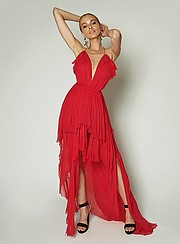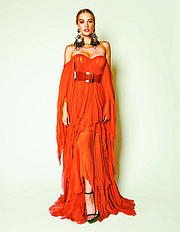FASHION
Michael Costello Goes from ‘Project Runway’ to His Own Design Studio
Fashion designer Michael Costello is known for his elegant evening gowns, which have been worn by the likes of Beyoncé, Lady Gaga, Jennifer Lopez and Katy Perry.
Costello, with a design studio and store in downtown Los Angeles, first became a household name when he participated in season 8 of TV’s “Project Runway” in 2010, coming in fourth. He then returned in 2012 for “Project Runway: All Stars,” placing third.
Costello sat down with the California Apparel News to explain his background, inspiration and design concepts.
When did you decide you wanted to be a fashion designer and why?
From a very young age, I saw my mother designing and sewing, and that sparked my interest. Eventually, she would teach me how to make my own pieces. I saw how much work was put into making these amazing garments and how happy it would make women feel to wear something that was created just for them. I thought, “I want to do that!”
How did you make that happen?
I opened my first boutique at a very young age and created dresses and other garments for women in Palm Springs, Calif. With the help of my mom and our passion to dress these wonderful ladies—through word-of-mouth and my clients’ loyalty—I was able to be a successful designer and boutique owner in this small desert town.
Who was the person who helped you the most in becoming a fashion designer?
My mother played the largest part in my success as a fashion designer. I also interned for Bob Mackie, a major celebrity fashion designer, at a young age, which put me ahead of a lot of the designers who were in my position.
Looking back on your first collection, what was it like and how would you change it now?
My first collections were the most authentic and most me. I think when you’re just starting off, you haven’t been influenced by the big and bad and you’re truly able to be yourself and just create. After being in the industry for so long, it’s hard not to take business essentials and ideas into consideration when starting a new collection. But at the end of the day, I wouldn’t change any of my collections or past creations.
What are the biggest challenges you find in creating a collection and how do you overcome them?
One of the biggest challenges I face is the feeling of needing to please everyone before me. There’s always that voice in the back of my head saying, “What if they don’t like it?” or “What if it’s not what they want to see?” I am lucky to have a great support system and team that motivate me to be myself and just to create for me.
Where do you get your inspiration?
I am inspired by all essence of beauty. I think women from all walks of life are beauty. When I design a dress, I like to first envision the woman wearing it—who she is, what her story is, where she’s going, etc. To me, I always get a sense of fulfillment not when a piece is complete but when I see a living and breathing human being wearing my collection.
What is your favorite part of being a fashion designer?
It is the freedom to show my genuine self through this intricate method of art. Many of my pieces are filled with time, love and hard work.
What skills are necessary to be a good fashion designer?
You need passion, motivation, creativity, discipline, self security and time management. It’s not all glamorous, celebrities and parties. This business and profession take so much time and focus to finally reach a comfortable state, and even then you have to find the next thing to push you and get you out of your comfort zone.
How would you describe your personal style?
I would describe my style as very cool and edgy. I’m almost always in black. I’m usually wearing my favorite denim—black jeans and a nice jacket. I love to dress up in a crisp, fitted suit when it’s called for, but I’m always looking for ways to edge up a casual look.
What is the best and worst feedback or critique you have received and from whom?
The best feedback I have gotten was from Diane von Furstenberg. She told me to listen to myself and continue to do what I’m doing because she knows I was born with this talent. Oprah said something similar to me. Nina Garcia gave me my “worst” feedback on my first “Project Runway” experience when I presented a look that was “too matchy-matchy” for her taste. I hadn’t had much styling experience at the time. But overall, there is no bad feedback.
How has the Los Angeles fashion industry changed since you started?
The Los Angeles fashion industry has evolved into trend makers and followers, and I’m not the biggest fan. Luckily, this city is full of originality, and with my showroom set in the heart of downtown I am able to meet so many designers, artists and creatives that it excites me when I meet someone who is so different from everyone else.
What advice would you give to emerging designers?
I would tell those designers to keep doing what they’re doing but with even more force than they are comfortable with. Go outside of that comfort zone and reach for new elements to bring to the table. The world is filled with creators and non-creators (cough cough, knock-offs), but you have to find what makes you different and roll with it.
























